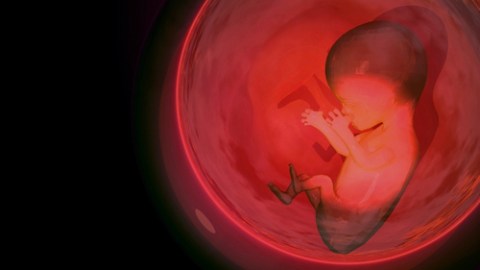Our Selves, Others’ Cells

Is it any solace to sentimental mothers that their babies will always be part of them?
I’m not talking about emotional bonds, which we can only hope will endure. I mean that within any woman who has ever been pregnant, some of her baby’s cells may live for as long as she lives. Some circulate in her bloodstream. Others take residence in her lungs, spinal cord, skin, thyroid gland, liver, intestine, cervix, gallbladder, spleen, lymph nodes, and blood vessels. And, yes, the baby’s cells can also live a lifetime in her heart and mind.
Here’s what happens.
During pregnancy, cells sneak across the placenta in both directions. The fetus’s cells enter the mother, and the mother’s cells enter the fetus. A baby’s cells are detectable in Mom’s bloodstream as early as four weeks after conception, and a mother’s cells are detectable in her fetus by week 13. In the first trimester, one out of every fifty thousand cells in her body are from her baby-to-be (this is how some noninvasive prenatal tests check for genetic disorders). In the second and third trimesters, the count is up to one out of every thousand maternal cells. At the end of the pregnancy, up to 6 percent of the DNA in a pregnant woman’s blood plasma comes from the fetus. After birth, the mother’s fetal cell count plummets, but some stick around for the long haul. Those lingerers create their own lineages. Think of colonies in the motherland.
Moms usually tolerate the invasion. This is why skin, organ, and bone marrow transplants between mother and child have a much higher success rate than between father and child.
Of course, we nosy mothers would like to know exactly what our children’s cells are up to while they hang out in us. Are they just biding time in our bodies? Are they mother’s little helpers? Or are they baby rebels, planning an insurgency?
It turns out that when fetal cells are good, they are very, very good. They may protect mothers from some forms of cancer. Fetal cells show up significantly more often in the breast tissue of women who don’t have breast cancer than in women who do (43 versus 14 percent). Why is this? Fetal cells are foreign to the mother because they contain DNA from the baby’s father. One theory is that this “otherness” stimulates the mother’s immune system just enough to help keep malignant cells in check.
The more fetal cells there are in a woman’s body, the less active are autoimmune conditions such as rheumatoid arthritis and multiple sclerosis. (Indeed, the more pregnancies a woman has had, the less likely she is to have multiple sclerosis.) These diseases improve during pregnancy and for some time afterward — suggesting that fetal cells help modify the mother’s immune response.
There’s also tantalizing evidence that fetal cells offer the mother increased resistance to certain diseases, by contributing immune system genes inherited from the father. These are new weapons in the war chest.
Some fetal cells have the potential to grow up and be anything. While many of the cells that enter the mother are immune system cells, some are stem cells. Stem cells have magical properties: they can morph into other types of cells (a process called differentiation), like liver, heart, or brain cells, and become part of those organs. Fetal stem cells migrate to injury sites—for instance, they’ve been found in diseased thyroid and liver tissue, and have turned themselves into thyroid and liver cells respectively. At the triage sites of wounds they accelerate healing, Fetal cells help reduce scars after pregnancy and restore the normal structure of the skin.
It’s striking, the evidence that a fetus’s cells repair and rejuvenate moms. Of course, evolutionarily speaking, the baby has its own interests in mind. It benefits from a healthy mother.
Then there’s baby on the brain. This is the truly startling stuff. Researchers working with mice have found evidence that cells from the fetus can cross a mother’s blood-brain barrier and generate new neurons. If this happens in humans—and there’s reason to believe it does—then it means, in a very real sense, that our babies integrate themselves into the circuitry of our minds. Could this help explain the remarkable finding that new mothers grow new gray matter in their prefrontal cortex (goals and social control), hypothalamus (hormonal regulation), and other areas of the brain?
The potential here is — mind-blowing. Could we use fetal stem cells to boost the brain, treat cancer and neurodegenerative diseases, and reverse the ravages of age? Harvested from the blood or organs of mothers, these cells, rife with regenerative properties, could be used therapeutically for a mother and her children. Fetal cells have advantages over other stem cells in that they don’t require the destruction of embryos or require cell cultures, which carry the risk of contamination. They’re unlikely to be rejected by the mother or child because, from an immune-system perspective, they’re only part “other.”
All is well when fetal cells are good, but when they are bad, they are horrid. They have shown up in cancers, and while they may be there to help, there’s also a suspicion that they’re not so innocent. There’s an explanation for this: fetal stem cells may act as cancer stem cells. This isn’t the only potential problem with cohabitation. While fetal cells may stimulate the mother’s immune system to be more vigilant, this dynamic can tip into something like violence. Mom may attack the fetal cells within, and in the crossfire her healthy cells get bombarded. The fetal cells themselves may also attack, the little traitors. What triggers these battles is unknown, but in the fallout mothers may suffer autoimmune diseases such as scleroderma and lupus.
The maternal cells circulating in a child’s body are no more predictable. Nearly 1 in every 100 cells in a fetus comes from her mom. The population plummets to something like 1 in 100,000 after birth, but enough of a mother’s special agents are still hiding out in her baby’s tissues, and their ranks may be refreshed by refugees in breast milk that slip into the bloodstream.
Maternal cells are busybodies. Some researchers think they train and shape the baby’s immune system and even decrease the risk of allergies. They’re healers too; there’s evidence that maternal stem cells can morph into, for instance, insulin-producing cells that proliferate and repair damaged tissue in kids with juvenile diabetes. And, like fetal cells in mothers, maternal cells in children may cause autoimmune problems.
When more than one person’s cells mingle in one individual, the effect is known as microchimerism. The root of microchimerism is the “Chimera,” an animal in Greek mythology. The Chimera is made up of the parts of multiple animals—and so, in a way, are we mothers.
How many people have left their DNA in us? Any baby we’ve ever conceived, even ones we’ve miscarried unknowingly. Sons leave their Y chromosome genes in their mothers. The fetal cells from each pregnancy, flowing in a mother’s bloodstream, can be passed on to her successive kids. If we have an older sibling, that older sibling’s cells may be in us. The baby in a large family may harbor the genes of many brothers and sisters. My mother’s cells are in my body, and so are my daughter’s cells, and half my daughter’s DNA comes from her dad. Some of those cells may be in my brain. This is squirm-worthy.
But there’s something beautiful about this too. Long post-postpartum, we mothers continue to carry our children, at least in a sense. Our babies become part of us, just as we are a part of them. The barriers have broken down; the lines are no longer fixed. Moms must be many in one.
Excerpted with permission by Free Press from Do Chocolate Lovers Have Sweeter Babies?: The Surprising Science of Pregnancy.




